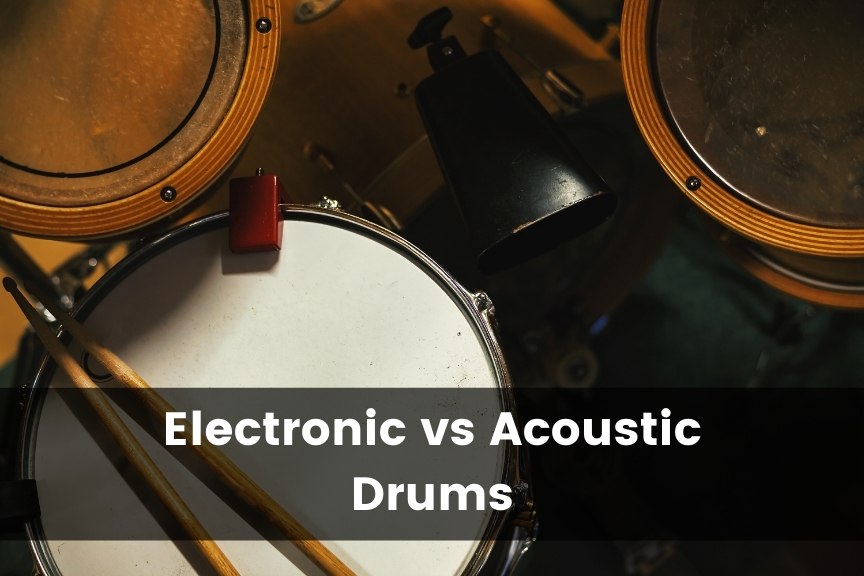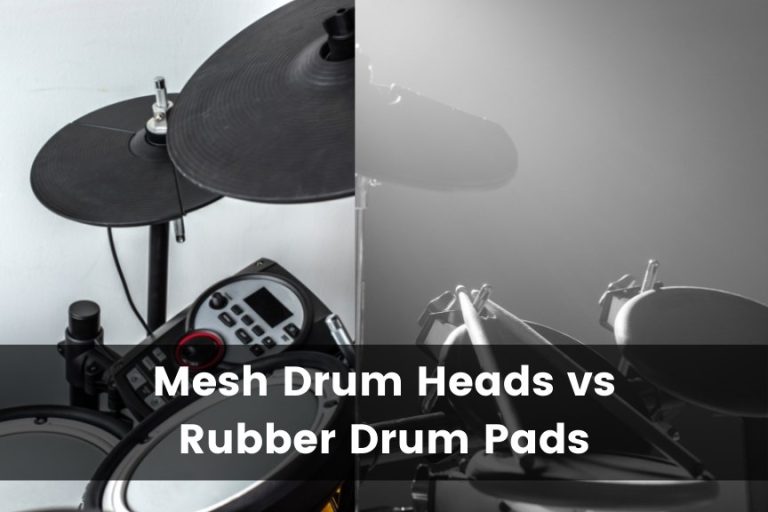Electronic vs Acoustic Drums: What’s the Difference?
If you’re saving up for an expensive new drum set, you want to ensure you get the best for your specific needs and budget. However, you’ll also need to understand the difference between electronic and acoustic drums, to decide best which kit is right for you. So, how are these kits different? This will be your ultimate guide to electronic vs acoustic drums.
Electronic drums differ from acoustic drums in that they consist of rubber, plastic, and mesh, while acoustic drums use wood and metal. Electric kits use sensors to create sound via a drum module, while acoustic drum sets’ sound is the natural consequence of the drumstick hitting the drumhead.
While some musicians are traditionalists and prefer the feel of an acoustic kit, many professional drummers are turning to electronic drum kits as their first choice. This article will explain the main differences between these two types of drums, so you can choose the one that’ll benefit you the most.
How Are Electronic and Acoustic Drums Different?
Electronic and acoustic drums are different in composition and functions. Electric kits use rubber or mesh pads, which make a minimal sound while playing unless you plug them into an output such as earphones, DAW, or amplifier. Acoustic drums produce sound naturally.
Acoustic drums are what we think of first when we hear “drum set”; they consist of cymbals, a bass, and a snare drum. The sound comes from striking these instruments with a drumstick, unlike with an electric drum. The electronic set uses speakers to produce sound after the pad sensors detect that you’ve hit them.
Both of these drum types have various benefits and downsides. Here’s what you’ll need to consider:
Electronic Drums
Pros
- You can unplug them for less noisy practice.
- It takes up less space.
- You can program specific sound samples to each drum pad.
- It doesn’t need tuning.
- It doesn’t need maintenance.
Cons
- It can become outdated quickly with advances in technology.
- It can create bad habits in drumming beginners.
- You need to find a set that doesn’t have too many limitations.
- It requires an outlet to run.
Acoustic Drums
Pros
- It works wonderfully with any acoustic music style.
- Better for beginners to develop their skills.
- You learn how to control the volume of your strikes.
- You learn how to take care of a drum kit properly.
- It takes less secondary equipment to use.
Cons
- It can be too loud if you have close neighbors.
- It takes up a lot of space.
- Acoustic drum kits often need parts replaced.
- Acoustic drums require frequent tuning.
Electronic Drums vs. Acoustic: Sound Creation
The fundamental difference between an acoustic and electronic drum kit is how they produce sound. So how exactly do these two kits produce sound?
Electronic Drum Sound
Electronic drums produce sound through single or multiple sensors underneath the mesh head or rubber pad. When you strike the pad, an electric signal travels through a cable to the drum module, which converts the strike into audible sound through your synthesizer, amplifier, or your DAW.
Acoustic Drum Sound
When a player strikes at a drum head, the air is compressed and expands on either side of the drumhead producing a vibration. The frequency of this vibration determines the sound of the player’s strike, with larger surfaces producing slow vibrations at a lower pitch.
Do Electronic Drums Feel Like Acoustic Ones?
Electronic drums feel like acoustic ones, but they’re never 100% the same since they consist of different materials. Many drummers say that they feel similar to play, although you can choose to have them make very different sounds.
For instance, you can choose from various sounds on an electric drum set. You don’t have to make it sound like an acoustic drum either- you can pick any sounds you want. As you practice, you’ll feel more in control with acoustic drums because how hard you hit the set directly impacts the sound it makes.
Modern electronic drums feel much more like acoustic sets than in the past. Although, it’s unlikely that manufacturers will be able to make them feel identical.
What Are the Benefits of Electronic Drums?
The benefits of electronic drums include the ability to reduce noise, easier recording, and built-in features. You can also practice wherever you want since you may easily take an electric drum kit with you when you travel.
Electronic drum sets are trendy today because of their versatility. Plus, the technology these kits use is continually improving. Let’s break down these benefits in more detail.
You Can Reduce Noise
The limited amount of noise electronic drums produce is essential for most people. If you live in an apartment, you won’t be able to practice at home with acoustic drums—they’ll probably be too loud for your neighbors.
Electronic drum kits don’t make much noise when you strike the rubber with a drumstick. You have the choice of connecting your drums to speakers or headphones, and you can also control the volume with the turn of a dial. All these features allow you to control the volume completely.
So, if you have close neighbors, they’ll never be able to hear you practicing. This feature is also great if you need to practice during the night.
It’s Simple To Record Music
It’s easier to record music using electronic drum kits than acoustic ones. You won’t need to soundproof your playing space, and the kit should come with a place to plug in your recording equipment.
Electric drums can even connect with your computer quickly, so you can mix and record without delay. Many drummers enjoy the convenience of being able to record their music at home.
You Get Built-In Features
Electronic drums also come with more features than acoustic ones. They can include tools such as metronomes, aux input, and even built-in learning tools to help you improve your drumming skills.
However, every electronic drum set comes with different features. You’ll want to think about what you want most in your drum set, then try to find one that covers the features you want the most.
Overall, beginners should get drum sets that come with learning tools. Services like Melodics connect with many electric MIDI drums and allow you to build your own practice routine. You’ll want to consider using something like this with your electric drum set to enhance your practice sessions.
It’s More Compact
You can take your drum kit with you wherever you need to go. The set isn’t nearly as bulky as acoustic ones. You can fold them and store the drums in a few travel cases, making them extremely easy to transport.
It’s much harder to bring an acoustic drum set with you, although it’s not impossible. However, choosing a compact electronic kit can make traveling with your drums easier.
Electronic drum sets also don’t take up nearly as much space, so you won’t need as large of a room to practice. Plus, you can always fold the set and store it when you finish practicing to get the space in your room back. Practicing in a dorm, apartment, or condo is much more convenient with these types of drums.
If you know you’ll need to take your drum kit with you everywhere, it’s usually better that you choose an electronic set. Some acoustic drum sets require more than one person to move them efficiently.
What Are the Benefits of Acoustic Drums?
The benefits of acoustic drums include learning drumming techniques, dynamic control, and feeling how the instrument responds to you. You also learn to take care of the drum and tune it, which are skills electronic-only drummers don’t get immediately.
You’ll learn much more from acoustic drum sets than electronic ones since they provide you with experiences you wouldn’t otherwise have. Electronic drums can’t wholly recreate realistic drumming sounds, so you’ll have a wider sound range as you learn all the techniques.
You Learn Drum Techniques
Learning all drum techniques is the most crucial benefit of using an acoustic set. Since you can play using touch, you can also control how the drum stick hits the set. Electronic pads only sense that you have hit them—but not always how.
That means, with acoustic drums, you can use all of these techniques:
- Drum rolls
- Buzz rolls
- Cymbal and crash rolls.
While electronic drums can also recreate these sounds, they don’t usually sound as realistic. Plus, you’ll learn how to perform these sounds with your sticks, which you can’t always do when using electric drum pads.
Many drum instructors recommend using acoustic drums to learn all these techniques. You’ll learn much faster when you can “feel” how to make and control the sounds.
You Learn To Maintain the Set
Next, you also gain experience in maintaining the set. Beginners who start with an electronic drum kit don’t need to learn how to take care of acoustic drums, which can cause problems later if they ever get a set.
An acoustic set will last longer than an electronic one, although you need to put more effort into taking care of it. Some beginners don’t realize that they need to change the skin on the drum head about every six months. If you don’t, the sound starts to change.
Learning to maintain your set now will help it last you many years. It would be best if you weren’t careless with your instrument.
You’ll Feel the Drums Respond
Acoustic drums allow you to easily see and feel how the drum responds to you when you strike it. That means you’ll learn how hard to hit the drums to get the sound level you want. You understand this faster when you can experiment with it in person.
Those who solely play electronic drums don’t need to practice how hard to hit the drum since they control the volume in other ways.
Lastly, you’ll form much better drum habits when you can feel the drum. You won’t hit it too hard, and you’ll have cleaner strikes. Acoustic drums are much better for practicing when you want to ensure that you don’t form bad habits.
They Sound Great With Other Acoustics
Acoustic drums sound wonderful with other acoustic instruments. You can also use them in various genres, so you’re sure to play them with others. Many musicians feel acoustic drums are great for group play in-person, while electronic drums make music production with groups over the internet go more smoothly.
If you love acoustic instruments, you can pair your drum with any of them. While electronic drums still sound great, many people prefer the sound of real drums over them.
You Only Need the Drums
You only need an acoustic set if you intend to practice learning the drums without recording anything. You can hear yourself playing easily, so you can note how you’re progressing.
Acoustic drum sets don’t require any special equipment to run. You don’t need to plug these drums into a power source or connect them with a speaker system. Many people appreciate sitting and playing whenever they want, without having to set up an extensive array of electronic equipment.
Plus, if you’re anxious to start learning, you only need to buy the drum kit. You won’t need to research and purchase sound equipment to be able to hear yourself playing. You can get to practicing and worry about buying other equipment later.
What Are Electronic Drums Made Of?
Electronic drums are usually made of plastic or metal. They have a shallow drum shell with a rubber or silicon material stretched over the surface. Inside the drum are sensors that let the equipment know when you’ve hit it with your sticks.
Electronic drum kits have many more parts than acoustic drums since a ton of sound equipment is involved. Unfortunately, any of these parts can break just like an acoustic drum. However, When something goes wrong, it can impact other electronic system parts.
The material that stretches over the drum shell needs to be tight enough to provide you with some stick rebound, making it feel closer to playing an acoustic drum. You can find different material options, although mesh, rubber, and silicone are the most common. The rest of the drum is usually metal or plastic.
You can expect an electronic drum set to last between five and ten years. Internal components slowly wear down as you strike the drum pad over and over, so you’ll want to ensure you get a durable set.
What Are Acoustic Drums Made Of?
Acoustic drums can be made of various materials, including wood, metal, polyester, or mylar. Often they consist of birch and maple wood, although hickory can provide better sound quality.
Traditionally, acoustic drums had animal skins, although that’s usually not the case anymore. The new skins are Mylar (a plastic film) and other synthetic materials, which sound good and last much longer than animal skins.
Metal drum kits can make use of several different materials, including:
- Steel
- Brass
- Bronze
- Aluminum.
Some materials are much more expensive, and pricier kits sound much better than cheaper ones. You’ll want to consider this when deciding what set you want to buy.
Overall, you can find acoustic drum kits in all kinds of styles and materials. It’s not uncommon for professional drummers to have different sets since they produce varying sounds depending on how the manufacturer made them.
Why Are Electric Drums More Expensive?
Electric drums are more expensive than many entry-level acoustic drums because they cost more to produce. They use more parts and need electronic wiring. Plus, they often feature digital tools, and the technology takes more research to make the sounds accurate.
If you need a budget drum set, you can often find used acoustic ones for cheaper than electronic sets. You also will want to buy a new electronic drum kit over a used one.
However, electric drum kits being more expensive doesn’t mean you’re getting ripped off; you’re mostly paying for more features. Electronic drums need to have a system of sensors and a sound module that sends noise to your speakers. These systems aren’t cheap to make, so you have to cover that cost.
Plus, you need a lot of secondary equipment with electronic sets. If you don’t have speakers or headphones, you won’t be able to listen to yourself playing the drums.
Acoustic drums don’t require any other equipment. So, you can play them without as much setup. It’s a lot faster to begin a practice session too.
Electric drums almost always have a heavier price tag than an acoustic set.
Are Electric or Acoustic Drums Better?
Electric drums are better for portability, noise reduction, and recording purposes. Acoustic drums are better for learning dynamic control, live play, and the versatility of drum techniques. Ultimately, which kit suits you best depends on how you intend to use them.
For instance, electric drums will better suit someone recording digital music in an apartment. This person could quietly perform and record music while wearing headphones, so they don’t disturb those around them. They’d get much more from an electric kit than an acoustic one.
However, a person performing in a band with other acoustic instruments might want to use traditional drums, so their sound doesn’t stand out too much.
In short, neither one of these instruments is better than the other—it all depends on what you want from the drum kit. You’re sure to appreciate one type more, depending on your situation. But that doesn’t mean that you can’t use both.
Conclusion
Electronic drums are easy to transport and have ports that make recording simple. On the other hand, acoustic drums are usually more affordable and help beginners learn correct techniques.
To summarize, there are many differences between electric and acoustic drums. When you learn one, you can usually switch to the other easily. However, you’ll want to buy a set that best suits your situation.







